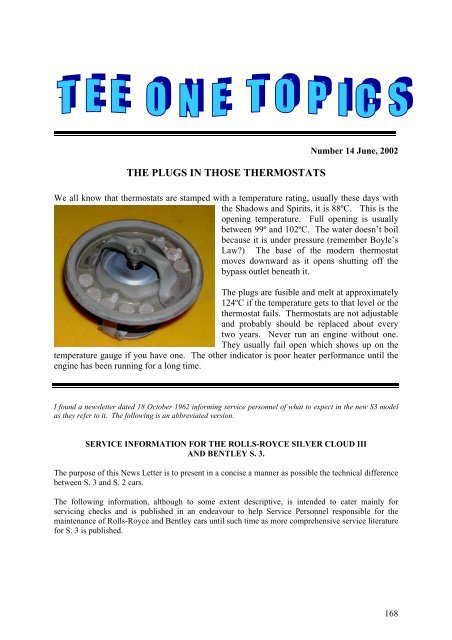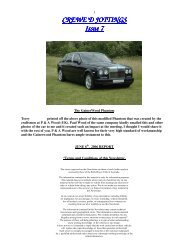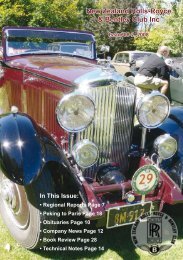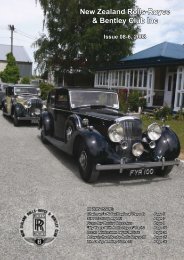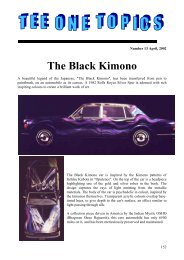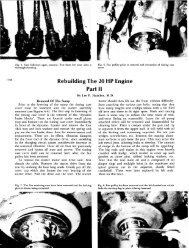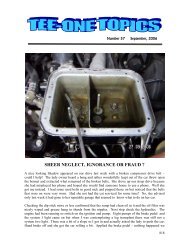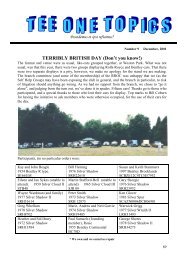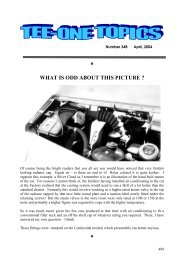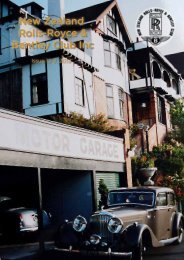June 2002 - Rolls-Royce Owners' Club of Australia (Victoria Branch)
June 2002 - Rolls-Royce Owners' Club of Australia (Victoria Branch)
June 2002 - Rolls-Royce Owners' Club of Australia (Victoria Branch)
Create successful ePaper yourself
Turn your PDF publications into a flip-book with our unique Google optimized e-Paper software.
THE PLUGS IN THOSE THERMOSTATS<br />
Number 14 <strong>June</strong>, <strong>2002</strong><br />
We all know that thermostats are stamped with a temperature rating, usually these days with<br />
the Shadows and Spirits, it is 88ºC. This is the<br />
opening temperature. Full opening is usually<br />
between 99º and 102ºC. The water doesn’t boil<br />
because it is under pressure (remember Boyle’s<br />
Law?) The base <strong>of</strong> the modern thermostat<br />
moves downward as it opens shutting <strong>of</strong>f the<br />
bypass outlet beneath it.<br />
The plugs are fusible and melt at approximately<br />
124ºC if the temperature gets to that level or the<br />
thermostat fails. Thermostats are not adjustable<br />
and probably should be replaced about every<br />
two years. Never run an engine without one.<br />
They usually fail open which shows up on the<br />
temperature gauge if you have one. The other indicator is poor heater performance until the<br />
engine has been running for a long time.<br />
I found a newsletter dated 18 October 1962 informing service personnel <strong>of</strong> what to expect in the new S3 model<br />
as they refer to it. The following is an abbreviated version.<br />
SERVICE INFORMATION FOR THE ROLLS-ROYCE SILVER CLOUD III<br />
AND BENTLEY S. 3.<br />
The purpose <strong>of</strong> this News Letter is to present in a concise a manner as possible the technical difference<br />
between S. 3 and S. 2 cars.<br />
The following information, although to some extent descriptive, is intended to cater mainly for<br />
servicing checks and is published in an endeavour to help Service Personnel responsible for the<br />
maintenance <strong>of</strong> <strong>Rolls</strong>-<strong>Royce</strong> and Bentley cars until such time as more comprehensive service literature<br />
for S. 3 is published.<br />
168
ENGINE<br />
The most significant change in the engine specification is that the compression ratio has been raised to<br />
9:1 on cars operating in countries where premium grade fuel is obtainable. In countries where only<br />
low octane rated fuel is obtainable, the 8:1 compression ratio is retained.<br />
The crankshaft is nitride hardened and incorporates sludge traps similar to those fitted to the S. 1. The<br />
connecting rods have been strengthened and 1. 000 in. diameter gudgeon pins are fitted. The gudgeon<br />
pins are <strong>of</strong>f -set . 062 in. in the piston towards the thrust side, on both the 8:1 and 9:1 compression<br />
ratio engines. In fact it is true to say that the only difference between the two engines is the<br />
configuration <strong>of</strong> the piston crown.<br />
The torque loading for the cylinder head nuts has been increased to 42-45 lbs/ft, the tolerances in the<br />
valve gear train have been tightened up and a strengthened camshaft gear is fitted. The timing gears<br />
are lubricated by a flow <strong>of</strong> oil which is directed between the gears at the point <strong>of</strong> me sh'.<br />
An enclosed breather system is fitted between the oil filler and the fresh air side <strong>of</strong> the butterfly in the<br />
induction manifold on all S. 3 engines.<br />
Engine Specification<br />
T ype<br />
cooled.<br />
Number <strong>of</strong> cylinders -<br />
Bore<br />
Stroke<br />
Displacement<br />
Compression Ratio 9:1 or 8:1<br />
Over square 90 0 V formation, liquid<br />
Eight - in two banks <strong>of</strong> four<br />
4.100 in.<br />
3.600 in.<br />
380.2 cu. in. (6230 cc.)<br />
Compression Pressure 9:1 ratio = 145 Ibs. sq.in. approx.<br />
Compression Pressure 8:1 ratio = 120 lbs. sq.in. approx.<br />
Carburetters<br />
The carburetters fitted to the S. 3 have been increased in size.<br />
Data<br />
Make & Model<br />
Choke size<br />
Jet size<br />
Jet needle<br />
Twin SU HD. 8. (side draught)<br />
2. 000 in.<br />
.125 in.<br />
us<br />
Ignition Distributor<br />
The new ignition distributor contains twin contact breakers which are so arranged that their actions<br />
overlap. In this way, one set <strong>of</strong> contacts connect the low tension circuit, while the second set <strong>of</strong><br />
contacts breaks the circuit to initiate the high tension spark. The contacts are operated by an eight-lobe<br />
cam.<br />
169
The timing <strong>of</strong> the spark is controlled with centrifugal governors and a vacuum operated diaphragm.<br />
The vacuum tapping is taken <strong>of</strong>f W bank carburetter at the throttle edge. The diaphragm is exposed to<br />
the low pressure obtained in the induction manifold and automatically advances and retards the<br />
ignition according to engine loading.<br />
An octane selector is fitted to enable one to adjust the ignition timing to suit low octane rated fuels.<br />
The octane selector is initially set in the fully advanced (W not '0') position to suit 95 or 100 octane<br />
fuels for 8:1 and 9:1 compression ratios respectively, For lower rated fuel the lock-nut should be<br />
released and the eccentric pin should be turned anti-clockwise retarding the ignition until a satisfactory<br />
performance is obtained.<br />
Only the Americans could do this to a Silver Spirit!<br />
All timing operations should be carried out on the contact breaker set furthest from the vacuum advance unit.<br />
The ignition timing should be set to the 'Al ' timing mark on the flywheel and not to the 1B41 flywheel marking.<br />
Make & Model<br />
Ignition Timing<br />
Contact Breaker Gap<br />
Lucas 20. D8<br />
2º Before top dead centre<br />
.014 in. - .016 in.<br />
Dwell Angle 31º - 37º<br />
Mark Location<br />
Flywheel<br />
Cent. Starts. R. P, M. 200-270<br />
Cent. Ends R.P.M. 1,500<br />
Max. Cent. Advance 17º - 19º<br />
Vac. Starts Hg. 5.1/2<br />
Vac. Ends Hg. 8<br />
Max, Vac. Advance 7º - 9º<br />
Direction <strong>of</strong> Rotation<br />
Anti-clockwise<br />
Firing Order 1,5,4,8,6,3,7,2.<br />
Contact Arm Spring Tension<br />
18-24 oz.<br />
Condenser Capacity<br />
.18 - .25 Mfd.<br />
170
Ignition Coil<br />
Sparking Plugs_<br />
Cooling System<br />
Make & Model Lucas HA. 12<br />
Make & Type Champion RN. 8<br />
A new thermostat has been introduced to provide a more accurate temperature control. The new thermostat<br />
which is rated at 82ºC is wax filled and' is not pressure sensitive. This means that this thermostat 'cracks, open at<br />
the actual temperature stated thereon. In the case <strong>of</strong> the gas filled thermostat used formerly, there was some<br />
delay in the opening, over the temperatures stated, as with this type the pressure in the cooling system retarded<br />
the opening <strong>of</strong> the thermostat.<br />
POWER ASSISTED STEERING<br />
The S. 3 is fitted with a development <strong>of</strong> the S. 2 power assisted steering system. The power assistance provided<br />
has been increased by<br />
(a) reducing the steering wheel rim load after which assistance is received from llb. to 1/2 lb. ,<br />
(b) reducing the rim load above whichvery much more steering effort is supplied by the<br />
power-assisting system from 8 - 10 lb. to 6 lb. and<br />
(c) by increasing the power -assistance received between these two points. These<br />
modifications have the effect <strong>of</strong> increasing the assistance received by the driver especially<br />
under parking conditions.<br />
In practice, this has been achieved by omitting two <strong>of</strong> the four reaction plunger pairs, along with their<br />
associated springs and spacing pins and reducing the number <strong>of</strong> springs in each secondary spring pack<br />
from twelve to six. Two anti-judder modifications have been introduced<br />
(a) providing a spool valve with swashed lands and<br />
(b) fitting restricted banjo-bolts in the steering-box to ram feed lines.<br />
The spool valve housing was produced initially with four bores for the reaction plungers, as on the S 2,<br />
but two <strong>of</strong> these bores were blanked <strong>of</strong>f with aluminium pins. At a later stage the housing was<br />
produced with the two redundant bores omitted.<br />
The front end geometry remains the same as for the S. 2.<br />
HEADLAMPS<br />
The S. 3 is fitted with a four headlamp system to provide more effective lighting which inevitably<br />
reduces the strain on the driver.<br />
The four headlamps are sealed beam units. The two inner lamps which are single filament light units<br />
are focused as 'main beam' for fast night driving and extinguish when the dip switch is operated. The<br />
171
two outer lamps are double filament light units with one filament set slightly out <strong>of</strong> focus to act as a<br />
supplementary main beam which also extinguishes on dip; while the other filament is focused for<br />
driving on dip and extinguishes when driving on main beam.<br />
On all cars except those destined for the U. S. A. the direction indicator switch is wired so that it acts<br />
as a combined direction indicator and headlamp flasher switch. With the main lamp switch in the<br />
'OFF' or ‘S & T’ position or driving with dipped headlights the flasher switch operates the main beam in<br />
each headlamp.<br />
INCONTINENT VALVE COVERS<br />
Ever since <strong>Rolls</strong>-<strong>Royce</strong> started leaning their engines over with the advent <strong>of</strong> the vee eight they<br />
have been beset with the problem <strong>of</strong> leaking covers. Traditionally a thick cork gasket has<br />
been set into grooves cast into the underside <strong>of</strong> the coverand that in turn is judiciously<br />
tightened down evenly to effect a seal. Unfortunately the cork with heat and time shrinks and<br />
further tightening is required until the cover is actually jammed onto the head. Further<br />
tightening is not only useless but is likely to crack the cover.<br />
To check for leaks examine the crankcase from below. The leaking oil will run down the sides<br />
<strong>of</strong> the engine and sump. Not only will the oil leak from around the seal but as happened to<br />
me recently when filling the engine the oil literally ran out <strong>of</strong> the seals around the mounting<br />
bolts on a 1985 Spirit. Some little time ago a neoprene type gasket was introduced which<br />
overcomes the shrinkage problem and provides an excellent seal. The leakage around the<br />
securing bolts was cured by fitting flat washers under the mounting bolts which have<br />
neoprene faces bonded to them. Owners <strong>of</strong> earlier cars will notice the larger blind bolts<br />
securing the cover on the Spirit. Tubular spacers over the studs prevent the cover from being<br />
over tightened.<br />
172
CHANGING THE AIR PUMP BELT<br />
The air pump was one <strong>of</strong> the innovations strapped onto the hapless engine <strong>of</strong> our cars in the<br />
seventies to reduce emissions. Basically<br />
the pump, sitting in the middle at the<br />
front <strong>of</strong> the engine drew in air behind its<br />
pulley and pumped it via pipes to the<br />
exhaust manifolds diluting the output<br />
just outside the valves. They give little<br />
trouble and keeping a good belt onthem<br />
seems to be the only maintenance<br />
required. But getting the belt <strong>of</strong>f is a<br />
challenge since it is very small and will<br />
not fit over the fan. The fan and viscous<br />
coupling can be removed as a unit but<br />
depending on the water pump hub used<br />
this can be very difficult. Another<br />
approach is to unbolt the actual fan from the coupling and thread the belt throught the space<br />
between the fan and the hub.<br />
THE TURBO BENTLEY WHICH COULDN’T<br />
One <strong>of</strong> these cars found its way into Canberra with a gearbox that wasn’t quite sure whether it<br />
had a top gear. The usual<br />
diagnosis <strong>of</strong> a faulty modulator<br />
unfortunately didn’t fit so up in<br />
the air and out with the box.<br />
Various labels on it suggested it<br />
had been overhauled at least<br />
twice in its young life by well<br />
advertised specialists from<br />
another State. Stripping<br />
showed a lot <strong>of</strong> clutch dust in<br />
the pan which was not<br />
unexpected. But the reason<br />
was not immediately apparent.<br />
These GM400 boxes have two sets <strong>of</strong> clutches and in this case the front set were almost worn<br />
to their base metal yet the rear ones were in excellent condition as shown in the picture.<br />
The centre bearing <strong>of</strong> the box which carries the whole rotating mass, showed peculiar wear<br />
around its mounting bolt.<br />
173
The picture shows three holes on the periphery. The centre one is threaded and receives the<br />
retaining bolt which passes<br />
throught the base <strong>of</strong> the main<br />
casing in the control valve area<br />
and the other two are the<br />
repective feed holes to the front<br />
and rear clutches.<br />
Examination <strong>of</strong> the main casing<br />
showed that the area where the<br />
above retaining bolt passes<br />
through the box was<br />
significantly distorted most<br />
probably through over<br />
tightening. This allowed the<br />
central carrier to move around<br />
in the box losing oil pressure to<br />
the front clutch and allowing<br />
the it to slip. Fortunately this was overcome by a thick bearing washer in the mounting hole,<br />
a new bolt and a replacement central bearing carrier. The finished job was reportedly<br />
excellent.<br />
A LITTLE MORE<br />
HOUSEKEEPING<br />
No prizes for identifying this as the<br />
space left after removing the<br />
windscreen washer reservoir on the<br />
right hand side <strong>of</strong> a Spirit engine bay.<br />
These little nooks harbour all sorts <strong>of</strong><br />
things that work their way up from the<br />
road and from droppings by people<br />
working on the engine. A good<br />
vacuum and then a careful wipe with a<br />
metho soaked cloth should be<br />
beneficial. It also allows wiring to be<br />
checked for chafing and loose connections. This car also had both mounting lugs broken <strong>of</strong>f<br />
the reservoir which were glued on with a standard cyanate glue. Whilst out the reservoir was<br />
cleaned <strong>of</strong> 16 years <strong>of</strong> sludge and sediment. The pump intake for the washer was found to be<br />
partially blocked with this stuff and the lines to jets benefitted from a good blow out.<br />
174
STYLE BY RADFORD<br />
One <strong>of</strong> my American correspondents sent me a photo <strong>of</strong> his Silver Cloud with a Radford conversion.<br />
I have only seen one <strong>of</strong> these in <strong>Australia</strong> and that seems to have disappeared. There are 5 known<br />
examples in the United States. Radford was Harold Radford, Coach builders <strong>of</strong> London. He was an<br />
engineer who had a project inWWII to outfit vans for paratrooper transport. That involved installing<br />
lots <strong>of</strong> cabinets and cubby holes for their gear. He took those skills and began a service converting<br />
cars to"Countryman Editions" He did several makes, including Jaguars, Minis, but mainly Bentleys<br />
and <strong>Rolls</strong>-<strong>Royce</strong> cars. At his peak, he was doing custom coachwork, including the body for the<br />
FordGT-40. In our cars, he started with the R type Bentleys, making a few shooting brakes<br />
(stationwagons) and continued through the Cloud III series. I understand he did about one car per<br />
month, mostly on Bentleys, and mostly right hand drive cars.<br />
From “The Cape Times” (Cape Town) "I have promised to keep his identity confidential,'<br />
said Jack Maxim, a spokeswoman for the Sandton Sun Hotel, Johannesburg, "but I can<br />
confirm that he is no longer in our employment". "We asked him to clean the lifts and he spent<br />
four days on the job. When I asked him why, he replied: 'Well, there are forty <strong>of</strong> them, two on<br />
each floor, and sometimes some <strong>of</strong> them aren't there'. Eventually, we realised that he thought<br />
each floor had a different lift, and he'd cleaned the same two twenty times. "We had to let him<br />
go. It seemed best all round. I understand he is now working for GE Lighting."<br />
175
SHADOW RAMS<br />
For those that have not seen<br />
them these are the gadgets<br />
that lift the rear <strong>of</strong> your<br />
shadow. The cylinder on<br />
the right screws onto the<br />
ram and in turn sits on the<br />
road spring suitably<br />
separated by an isolator that<br />
insulates and locates the<br />
coil. It also allows shims to<br />
be placed above the spring<br />
to adjust the height.<br />
interesting shots – this is but one. More has been promised!<br />
George Shores had most <strong>of</strong><br />
the rear end out <strong>of</strong> his<br />
Shadow II recently when I<br />
managed to get some<br />
ONE APPROACH<br />
A police <strong>of</strong>ficer pulls a driver over for speeding and has the following exchange:<br />
Officer: May I see your driver's license?<br />
Driver: I don't have one. I had it suspended when I got my 5th DUI.<br />
Officer: May I see the owner's card for this vehicle?<br />
Driver: It's not my car. I stole it.<br />
Officer: The car is stolen?<br />
Driver: That's right. But come to think <strong>of</strong> it, I think I saw the owner's<br />
card in the glove box when I was putting my gun in there.<br />
Officer: There's a gun in the glove box?<br />
Driver: Yes sir. That's where I put it after I shot and killed the woman<br />
who owns this car and stuffed her in the boot.<br />
Officer: There's a BODY in the BOOT?!?!?<br />
Driver: Yes, sir.<br />
Hearing this, the <strong>of</strong>ficer immediately called his captain. The car was quickly surrounded by<br />
police, and the captain approached the driver to handle the tense situation:<br />
176
Captain: Sir, can I see your license?<br />
Driver: Sure. Here it is.<br />
It was valid.<br />
Captain: Who's car is this?<br />
Driver: It's mine, <strong>of</strong>ficer. Here's the owner's card.<br />
The driver owned the car.<br />
Captain: Could you slowly open your glove box so I can see if there's a gun in it?<br />
Driver: Yes, sir, but there's no gun in it.<br />
Sure enough, there was nothing in the glove box.<br />
Captain: Would you mind opening your boot? I was told you said there's a body in it.<br />
Driver: No problem.<br />
Boot is opened; no body.<br />
Captain: I don't understand it. The <strong>of</strong>ficer who stopped you said you told him you<br />
didn't have a license, stole the car, had a gun in the glove box, and that there was a<br />
dead body in the boot.<br />
Driver: Yeah, I'll bet the lying bastard told you I was speeding, too!<br />
A LIFTING COMPARISON<br />
A friend <strong>of</strong> Doug Bindon-Howell, John Wyers turned up in his very smart Citröen. When he<br />
opened the bonnet there was a very familiar sight. The accumulator on the right is one <strong>of</strong><br />
eight fitted to his car, the one on the left is one that I had removed for replacement from<br />
Doug’s Spirit.<br />
Dimensionally they<br />
were identical as were<br />
the charged pressures.<br />
Apparently the spheres<br />
differ throughout the<br />
Citröen by the use <strong>of</strong><br />
restrictors in the neck <strong>of</strong><br />
the unit which are<br />
swaged in. The other<br />
difference is that the<br />
Citröen units are a third<br />
<strong>of</strong> the cost <strong>of</strong> the RR<br />
items! And the<br />
enthusiasts re-charge<br />
them!!<br />
177
Doug Bindon-Howell, despite my most venemous threats refuses to delve into the intricacies<br />
<strong>of</strong> his car, a magnificent 1985 example <strong>of</strong> a Silver Spirit. The car had covered some 42,000<br />
kilometres in 16 years and if anything, had perished rather than worn in the interim. But he<br />
loves the car with a passion, particularly the way it drives. And he also appreciates the<br />
provenance <strong>of</strong> the breed, something that seems to be completely lost on the younger driver.<br />
Recently Doug came across a 40 year old article by Laurance Pomeroy one <strong>of</strong> the UK’s then<br />
more notable social commentators. It is <strong>of</strong>fered for your enjoyment.<br />
On Running a <strong>Royce</strong><br />
BY LAURENCE POMEROY<br />
WHEN SURVEYING thirty-five years <strong>of</strong> adult life the missed opportunities are all too clear. If in 1927,<br />
following a rather good report on the six-wheeler motor coach situation in Germany, I had taken the <strong>of</strong>fered job<br />
with one <strong>of</strong> possibly the managing director, <strong>of</strong> one <strong>of</strong> Britain's leading industrial concerns; if 1 had followed the<br />
advice to stand as a National Liberal candidate in 1931 I might have possibly been in the Cabinet today; if 1 had<br />
pursued and married the heiress whom I met at the Conservative College at Ashridge in 1936 1 should now be<br />
prominent in potted meat; most significant <strong>of</strong> all, if 1had not been excluded by a car accident from joining the<br />
Navy in 1920 1 might today be one <strong>of</strong> their Lordships. Mercifully there are credits as well as debits, and I count<br />
this day <strong>of</strong> writing, <strong>June</strong> 22, 1962, as the first anniversary <strong>of</strong> an indubitably wise decision. This was to spend<br />
£1,350 in the purchase <strong>of</strong> a 4¼ litre Silver Wraith <strong>Rolls</strong>-<strong>Royce</strong>, Chassis No. WFC 83, with an undivided H. J.<br />
Mulliner four-seater saloon body which was delivered to its first owner by Jack Barclay in 1950 and had since<br />
put 91,346 miles on the clock. The vendor was Harry Martin, who assured me that the engine was not yet run in<br />
after a complete overhaul, and that the front suspension unit had been reconditioned. Despite this and the<br />
generally excellent external condition <strong>of</strong> the car I was aware that for this sum 1 could buy a new 3-litre car with<br />
disc brakes and an automatic gearbox, capable <strong>of</strong> 100 m.p.h., with ample enclosed luggage space and an<br />
all-round fuel consumption <strong>of</strong> 17-19 m.p.g. Bearing in mind that at least half my hourly motoring is in London, I<br />
was somewhat apprehensive about the driving <strong>of</strong> so large a car in London traffic and parking it in London<br />
streets. It could not fail to cross my mind that the running costs, after such a considerable mileage, could be<br />
expensive in terms <strong>of</strong> petrol, oil, maintenance and repairs.<br />
Putting these prudent doubts resolutely behind me I had little hesitation in closing the deal after a two-mile road<br />
test round Regent's Park. Now, after twelve months, I can make a report which may be interesting to the general<br />
reader and <strong>of</strong> value to persons who contemplate following in my footsteps. The main merit <strong>of</strong> the car has been its<br />
unfailing reliability. With 106,299 miles now on the clock the mileage in the past year has been 14,753, and the<br />
only mechanical failure a leaking exhaust manifold gasket, which, annoyingly enough, spoiled a 100 per cent<br />
record a week ago. The mechanical chassis lubrication system eliminates monthly maintenance and the only<br />
required service attentions, for items which have become less than 100 per cent, but which have left the car<br />
completely driveable, have been the replacement <strong>of</strong> a rather tired electric wiper mechanism; relining the brake<br />
servo; eliminating stickiness in the horn button; replacing the electric clock; and fitting a distributor arm <strong>of</strong> the<br />
right make in place <strong>of</strong> the foreigner mysteriously in its place when the car was bought.<br />
There have been three regular service attentions and four new Dunlop tyres, which still have another year's use<br />
in them. The coachbuilt body has also needed attention from time to time, more especially in clearing the drain<br />
pipes from the sliding ro<strong>of</strong> and in striking the right balance between doors tending to stick and others producing<br />
a slight rattle. During a day's work Mr Fred Connolly had his men bring the hide upholstery up to a condition<br />
barely discernible from what it had been twelve years previously. In round figures the cost <strong>of</strong> maintenance and<br />
178
mechanical work has been £75; on the body £30; the electrics £15; and the tyres, say, £30. Total maintenance<br />
had thus amounted to £150 This would have been less if a new car had been bought, but in their first 5,000 or<br />
10,000 miles new cars can be subject to endless teething troubles and it would have been exceptional to have had<br />
the use <strong>of</strong> such a vehicle for more than forty-nine weeks out <strong>of</strong> fifty-two. Even if all the work were done free<br />
under guarantee, there would still be a bill <strong>of</strong> £50 for hire <strong>of</strong> a substitute, a half worn-out set <strong>of</strong> tyres (around<br />
£20), so that in sum one has a figure for a new car <strong>of</strong> about £100, together with the misery <strong>of</strong> many minor<br />
ailments which it seems almost impossible avoid. A motor car is an assembly <strong>of</strong> 20,000 pieces, and if put<br />
together with an external accuracy <strong>of</strong> 99.9 per cent will be delivered to the customer with twenty things wrong.<br />
In my youth it was commonplace for every chassis to be driven on the road with a soapbox body for a week or<br />
two before being fitted with its body then for a further week in order to seek and rectify minor defects before the<br />
buyer had the car. Such procedure would be prohibitively expensive today and the owner <strong>of</strong> a modern car who<br />
complains <strong>of</strong> unreliability should bear in mind that he has paid a basic price <strong>of</strong> £1000 for a car superior to one<br />
which in pre-war periods would have cost him £4,000 in terms <strong>of</strong> modern money. In the <strong>Royce</strong> any journey,<br />
however long or short, is rewarding.<br />
Starting from rest, a slight whine on the first gear (belying the fact that the designed life is one and a half hours<br />
at full torque) soon changes to a barely audible hum on the two indirect ratios which are engaged with the utmost<br />
smoothness by small movements <strong>of</strong> the short right-hand gear lever. Clumsiness with the clutch or gear lever<br />
brings immediate protest, but reasonable skill gives superlative response. The driving position is as near perfect<br />
as can be and, although this is not a car intended to be hurled through corners at sports-car speed, the steering in<br />
itself is, from the hand-wheel to the road-wheel, made to such a pitch <strong>of</strong> efficiency that it constantly signals to<br />
the driver the equation <strong>of</strong> cornering force and road surface, and reflects without perceptible loss in time or effort<br />
every response <strong>of</strong> the driver. Thus, whether one is threading one's way through traffic leaving bare inches on<br />
each side, or sweeping round a main road curve, the <strong>Royce</strong> sets an example which is rivalled by no more than<br />
half a dozen models <strong>of</strong> today, <strong>of</strong> which four are made in Italy.<br />
From the viewpoint <strong>of</strong> the driver the elevated seating position is <strong>of</strong> value in evaluating the traffic as well as<br />
giving a good view <strong>of</strong> the surrounding country. On the open road, and since Sir Henry <strong>Royce</strong> adapted the<br />
Hispano Suiza braking system for his cars in 1924, the stopping power <strong>of</strong> these vehicles has been rightly<br />
renowned for low pedal pressure, even response and absolute consistency; but minimum stopping distance has<br />
been less remarkable, and it would be absurd to pretend that my 1950 car can equal the all-round merit <strong>of</strong> a 1962<br />
design with disc brakes on all four wheels. This notwithstanding, in city work the braking system must be rated<br />
excellent, and on the open road it is more than adequate in relation to a true maximum speed <strong>of</strong> around 8o m.p.h.<br />
and a normal cruising speed <strong>of</strong> 70 m.p.h.There may be many who would regard road speeds <strong>of</strong> this order, with<br />
an inability to out-accelerate a Minx or Victor, a genuine deprivation, but this is something which is 'all in the<br />
mind', and a level <strong>of</strong> performance acceptable on a car which is running safely, silently and smoothly might be a<br />
misery on a low-priced production car which was short, brutish and nasty. Compared with a new car <strong>of</strong><br />
comparable price one must, in given circumstances, be prepared to sacrifice 5-7 miles in each hour <strong>of</strong> running<br />
time,so that if you were to start on a new car at 9 a.m. and stop for luncheon at 1.00 p.m. I and my old <strong>Royce</strong><br />
would be twenty miles or so away, and would arrive about half an hour later. To <strong>of</strong>fset the depressing prospect<br />
<strong>of</strong> thus missing two or three aperitifs is the fact that the <strong>Royce</strong> is not just a restful car; it is a positive therapeutic.<br />
1 have <strong>of</strong>ten (truthfully) said that certain cars could be driven 400 miles in a day without physical exhaustion,<br />
but the <strong>Royce</strong> is the only one I know in which I can start in the morning physically exhausted (from causes into<br />
which we need not enter) and finish the day's run wholly revivived<br />
This thaumaturgy I explain by the fact that cruising at 70 in silence is restful; the steering and brakes combine to<br />
give a sense <strong>of</strong> continuous security; the succession <strong>of</strong> views from the high placed seats is intellectually<br />
stimulating; and the general respect that is paid to the car is emotionally satisfying. The music from the<br />
Radiomobile transistor radio is reproduction <strong>of</strong> a very high order and the comfort <strong>of</strong> the seats is at least the equal<br />
<strong>of</strong> the armchair from which I am now dictating this article. These pleasures on the journey are greatly fortified<br />
by the practical picnic equipment. The pull-down tables are sufficiently big to permit a tablecloth with plate,<br />
knife and fork, and a glass, with a bottle <strong>of</strong> fizz placed upon a supplementary shelf which opens up below.<br />
Sunshine and fresh air can pour in through the sliding ro<strong>of</strong> and can be enjoyed both when stationary and at any<br />
speed. It has well been said that every gentleman's house should have a gallery in which he may walk in the<br />
afternoon should it rain. I feel that no car is complete without some form <strong>of</strong> opening head. A further joy <strong>of</strong> the<br />
179
Mulliner body <strong>of</strong> WFC 83 is the ease with which one may move, 1 had almost said walk about, inside it. A<br />
matter <strong>of</strong> moment is that the 'B' pillar is sufficiently behind the front seats to make possible the insertion <strong>of</strong><br />
parcels between them and the rear bootrest without opening the rear doors.Only when picnicking, and taking an<br />
occasional nap by the side <strong>of</strong> the road, have I myself had cause to appreciate the exceptional legroom in the rear<br />
compartment, but my adult passengers have waxed enthusiastic at being able fully to extend their legs, and when<br />
visiting my daughter's school I have found it quite easy to take her and four friends to make a seven-seater load.<br />
important than the somewhat exiguous enclosed, lockable luggage space, but if one has any faith in human<br />
nature it is possible to divide the load by an ingenious Mulliner refinement.<br />
Having first stowed any delicate personal effects or tender luggage, these can be isolated from wind and weather<br />
by pulling down a roll-top after which a full-sized cabin trunk can be strapped on to the nearly horizontal<br />
luggage platform, distance pieces being swung up so that the bodywork cannot be harmed, and the tail itself held<br />
at an angle for added security. In this fashion it is probable that more luggage can be carried on the car than with<br />
a current design, but, taken all round, I do not pretend that the efforts <strong>of</strong> the engineers at Crewe in the past dozen<br />
years have been wholly in vain. The latest cars enjoy power steering and can sustain far higher road speeds; they<br />
are immune from the small draughts which it is almost impossible to eradicate from an elderly car and they have<br />
an altogether higher standard <strong>of</strong> heating and ventilation. Moreover, suspension has come a long way since the<br />
immediately post-war period. A wheel encountering a manhole cover sends a shock through the relatively<br />
flexible frame <strong>of</strong> WFC 83, which is in turn followed by shake through the hand-made structure <strong>of</strong> the Mulliner<br />
body, and certain kinds <strong>of</strong> wavy road surface will promote a strong pitching motion. The wise man will, with<br />
such a car, slow right down before traversing a passage ~ niveau in France; it is manifestly incorrect to translate<br />
this phrase by the English 'level crossing’. However, the general behaviour <strong>of</strong> the 1950 car's suspension on rough<br />
French roads is far better than one might expect it to be from isolated examples <strong>of</strong> poor British roads. One thing<br />
remains common, irrespective <strong>of</strong> the country in which one is motoring, or the model one is driving. This is 'The<br />
Magic <strong>of</strong> a Name'. Very soon after I had bought WFC 83 a friend said that he assumed I had been animated<br />
mainly by the initials on the radiator. This is not true, but 1 agree that the prestige <strong>of</strong> the car is an added<br />
attraction, more especially as I conceive it to be snob in the French, but not in the British, meaning <strong>of</strong> the word.<br />
Certainly no car could be further removed from presque cad. This instant and well-nigh universal recognition <strong>of</strong><br />
top quality has many practical advantages as well as being an occasion for personal pride. Egress from side<br />
turnings is eased by the way in which other traffic halts; police assist; attendants at car parks which look full find<br />
that extra little space; when visiting factories one is waved on to the director's entrance. Also important to many<br />
people, including myself, is that a car <strong>of</strong> this kind is 'neutral' in the sense that one is not insulting any other<br />
manufacturer by failing to run a car <strong>of</strong> his make.Last, but by no means least, is the attraction <strong>of</strong> first-class detail.<br />
The throttle, the ride control, a fuel gauge accurate to less than half a gallon, companions in the rear quarters,<br />
subtle interior lighting, and front seats by which after being pushed back to ease exit subsequently latch on to a<br />
pre determined position when moved forward, are minor items which in all give a major feeling <strong>of</strong> satisfaction.<br />
And all these good things are to be had for nothing even after allowing the extra £50 as compared with a modern<br />
car in respect <strong>of</strong> maintenance and using 100 gallons more fuel and 10 gallons more oil to give a total cash<br />
'premium' <strong>of</strong> £8o. For in fact this £80 is turned from a loss to a pr<strong>of</strong>it by the movements <strong>of</strong> the second-hand<br />
market. These fix the depreciation <strong>of</strong> the possible new Blank or Dash at £525 during the past twelve months, and<br />
for the <strong>Royce</strong> at £350, so that I emerge from the wholly satisfactory deal with a benefit <strong>of</strong> £95. Even friends who<br />
said that my purchase <strong>of</strong> the <strong>Royce</strong> was an extravaganza crowning a lifetime in which I have been continuously<br />
suspended over the abyss <strong>of</strong> bankruptcy by the cantilever <strong>of</strong> credit, cannot deny this to be a good thing. Thus<br />
with reason 1 drive this splendid memorial to a man who was one <strong>of</strong> the world's great mechanics, in a state <strong>of</strong><br />
euphoria which enables me to reflect that perhaps all does turn out for the best in the long run. 1 do not have the<br />
instinct for pr<strong>of</strong>it which is the hall-mark <strong>of</strong> the first-class businessman since, in the words <strong>of</strong> the good Queen,<br />
'we have gone sliding down into Democracy' politics have become a dreary, as well as a traditionally dirty game;<br />
zeal for potting meat might well have been short lived; and an alternative to Admiralty could well be lying full<br />
fathom five, my bones <strong>of</strong> coral made.<br />
180
FILTERS<br />
Neat paper filters have been fitted to all Shadows and Spirits and not infrequently tired mechanics have<br />
discarded them on the basis that the under floor primary filter will do all that is necessary. They are a standard<br />
commodity and should be available from your friendly local carburetter shop. Don’t forget to replace the ‘O’<br />
ring. The plug is extracted by a standard 7/16’ AF bolt.<br />
Bonnet pads<br />
These get pretty crappy with time. They<br />
are designed to be fire pro<strong>of</strong> sound pro<strong>of</strong><br />
and heat pro<strong>of</strong> so if you are having them<br />
remade select your materials carefully.<br />
They can usually be removed and cleaned<br />
with care. The retaining clips have been<br />
re-designed and are readily available.<br />
WAYNE’S WORLD<br />
Wayne Wardman has been a busy owner over the last couple <strong>of</strong> months as will be seen by the<br />
following contributions.<br />
Upgrading Silver Shadow II Front Roll Bar<br />
Not being a lover <strong>of</strong> body roll I have just replaced my front roll bar with a replacement obtained from Kellow-<br />
Falkiner in Melbourne. (I replaced the rear two years ago and this has been documented elsewhere.)<br />
I removed the protective paint and re-did it in POR 15 for a more lasting protection.<br />
181
The new bar necessitates upgrading the rubber bushes, which are from the Turbo R. They are however far from a<br />
perfect fit and considerable effort went into widening the internal diameter from the 27mm standard to 31mm.<br />
I did this by heating a copper pipe and burning away the rubber – vernier in hand. A laborious task. (George<br />
Shores, on hearing this , purchased an abrasive flapper and fitted it to a drill – making that part <strong>of</strong> the task one <strong>of</strong><br />
a few minutes only!)<br />
The outer dimensions needed some trimming to fit in the retaining catch. This I did by careful use <strong>of</strong> a grinder.<br />
Once in position some ritual application <strong>of</strong> POP 15 was undertaken on exposed metal and she was ready for a<br />
trial.<br />
The result was wonderful, body roll being decreased by about a third. The bar cost $170 and each bush $14, so it<br />
is a reasonable exercise for the considerable gain.<br />
Replacing Scuttle Foam on Shadows<br />
The foam air filter under the Shadow bonnet scuttle deteriorates with time and replacement is simple and<br />
inexpensive.<br />
Go to a rubber and foam supply shop and ask for 3mm foam – take a sample if in doubt.<br />
The scuttle is 3 feet by 4 inches.<br />
To remove the scuttle, raise the bonnet. This gives access to the five 2 BA retaining screws.<br />
Release these and refurbish if necessary – treat rust and repaint etc. The scuttle with its water hose can be<br />
inverted. (This is also a good opportunity to ensure that the drain hole is clear.)<br />
Carefully separate the old foam from the scuttle and use this as a template to cut a fresh piece <strong>of</strong> foam.<br />
Site the new foam making sure it fits properly at the rear side.<br />
Replace the 5 screws and the job is finished.<br />
Fitting the high brake light to a Shadow<br />
This is now getting to be an S.O.P. in these cars.<br />
182
If undeliverable please return to Post Office Box 8 MAWSON 2607 ACT AUSTRALIA<br />
POSTAGE<br />
PAID<br />
AUSTRALIA<br />
183


